-
 Bitcoin
Bitcoin $108,250.0992
0.11% -
 Ethereum
Ethereum $2,515.9404
0.03% -
 Tether USDt
Tether USDt $1.0003
0.00% -
 XRP
XRP $2.2166
-0.19% -
 BNB
BNB $656.5904
0.29% -
 Solana
Solana $147.4122
-0.58% -
 USDC
USDC $1.0000
-0.01% -
 TRON
TRON $0.2830
0.06% -
 Dogecoin
Dogecoin $0.1641
0.27% -
 Cardano
Cardano $0.5739
-0.19% -
 Hyperliquid
Hyperliquid $39.1463
-0.11% -
 Sui
Sui $2.8882
-0.02% -
 Bitcoin Cash
Bitcoin Cash $487.6428
0.31% -
 Chainlink
Chainlink $13.2097
0.07% -
 UNUS SED LEO
UNUS SED LEO $9.0308
0.10% -
 Avalanche
Avalanche $17.8608
0.13% -
 Stellar
Stellar $0.2379
-0.06% -
 Toncoin
Toncoin $2.7400
-0.39% -
 Shiba Inu
Shiba Inu $0.0...01144
-0.36% -
 Litecoin
Litecoin $87.5467
0.66% -
 Hedera
Hedera $0.1538
0.22% -
 Monero
Monero $315.5479
0.36% -
 Dai
Dai $1.0000
0.00% -
 Polkadot
Polkadot $3.3523
-0.71% -
 Ethena USDe
Ethena USDe $1.0003
0.01% -
 Bitget Token
Bitget Token $4.3960
-1.03% -
 Uniswap
Uniswap $7.2663
4.19% -
 Aave
Aave $272.8619
2.04% -
 Pepe
Pepe $0.0...09676
-0.18% -
 Pi
Pi $0.4586
-2.87%
Where is the strong support level shown by UNI's IOMAP indicator?
The IOMAP indicator helps UNI traders identify strong support levels at $5.00, $6.00-$7.00, and $8.00, where investors are likely to defend their positions.
Apr 27, 2025 at 08:28 am
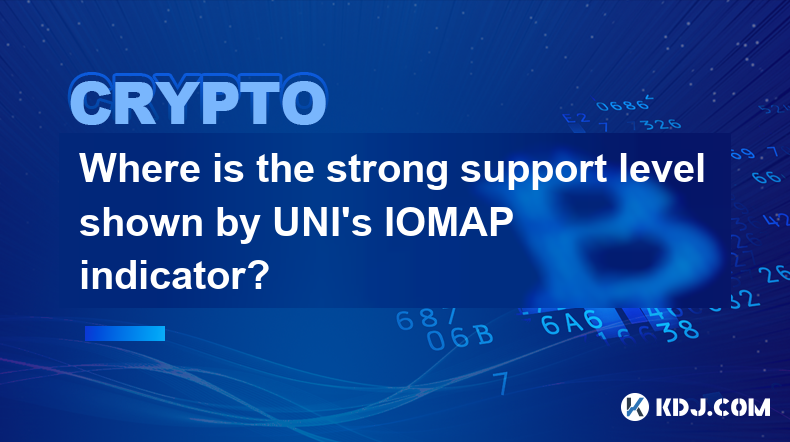
The IOMAP (In/Out of the Money Around Price) indicator is a powerful tool used by cryptocurrency traders to identify key support and resistance levels. For the UNI (Uniswap) token, this indicator helps in pinpointing where significant clusters of investors have bought their tokens, which can act as strong support levels. In this article, we will delve into how the IOMAP indicator works and identify the strong support levels for UNI based on this data.
Understanding the IOMAP Indicator
The IOMAP indicator essentially maps out the distribution of addresses that have purchased UNI at different price points. By analyzing this data, traders can see where there are concentrations of investors who are either "in the money" (holding tokens at a profit) or "out of the money" (holding tokens at a loss). These zones can act as support or resistance levels, depending on the current price of the token.
How to Access the IOMAP Data for UNI
To access the IOMAP data for UNI, traders typically use blockchain analytics platforms like IntoTheBlock or Glassnode. Here is a step-by-step guide on how to view the IOMAP data for UNI using IntoTheBlock:
- Visit the IntoTheBlock website and navigate to the UNI token page.
- Select the IOMAP indicator from the list of available metrics.
- Adjust the time frame if needed to see historical data or focus on recent activity.
- Analyze the chart to identify where the clusters of addresses are located.
Identifying Strong Support Levels for UNI
Upon analyzing the IOMAP data for UNI, we can identify several key price levels where significant clusters of addresses have bought their tokens. These levels are critical as they represent points where investors are likely to defend their positions, thus providing strong support.
- Around $5.00: There is a notable concentration of addresses that bought UNI at this price level. This suggests that if the price of UNI approaches $5.00, these investors might see it as a buying opportunity to break even or minimize losses, thereby providing strong support.
- Between $6.00 and $7.00: Another significant cluster of addresses is found in this range. Investors who bought UNI within this range would likely view any dip to these levels as an opportunity to add to their positions, reinforcing the support level.
- At $8.00: A smaller but still significant group of addresses purchased UNI at this price. This level could act as a psychological support point, especially if the broader market sentiment remains positive.
Analyzing the Impact of Support Levels
The strength of these support levels can be influenced by various factors, including overall market sentiment, trading volume, and the behavior of large holders (whales). For instance, if the market is bullish and trading volumes are high, the support levels identified by the IOMAP indicator are more likely to hold firm. Conversely, in a bearish market with low trading volumes, these levels might be breached more easily.
Practical Application of IOMAP Data
Traders can use the IOMAP data to make informed decisions about entry and exit points. For example, if UNI's price is approaching a strong support level identified by the IOMAP indicator, a trader might consider buying the token, anticipating that the price will rebound from this level. Conversely, if the price is nearing a resistance level with a significant cluster of addresses, it might be a good time to sell or take profits.
Case Study: UNI's Price Action Around Identified Support Levels
To illustrate the practical application of the IOMAP indicator, let's look at a recent example of UNI's price action around the identified support levels. In early 2023, UNI's price dipped to around $6.50, which is within the identified support range of $6.00 to $7.00. As predicted by the IOMAP data, this level held as a strong support, and the price rebounded shortly after, validating the effectiveness of the indicator.
Limitations of the IOMAP Indicator
While the IOMAP indicator is a valuable tool, it is not without its limitations. It does not account for external market factors such as regulatory news, macroeconomic trends, or sudden shifts in investor sentiment. Therefore, it should be used in conjunction with other technical and fundamental analysis tools to make well-rounded trading decisions.
Frequently Asked Questions
Q: Can the IOMAP indicator predict future price movements?
A: The IOMAP indicator does not predict future price movements but rather provides insights into potential support and resistance levels based on historical data. It is a tool for understanding where investors might buy or sell, but it should be used alongside other analysis methods for more accurate predictions.
Q: How often should I check the IOMAP data for UNI?
A: It is advisable to check the IOMAP data regularly, especially during periods of high volatility or when UNI's price is approaching identified support or resistance levels. Daily or weekly checks can help you stay updated on any shifts in the distribution of addresses.
Q: Are there other cryptocurrencies for which the IOMAP indicator is useful?
A: Yes, the IOMAP indicator can be applied to any cryptocurrency with sufficient on-chain data. Popular tokens like Bitcoin, Ethereum, and other major altcoins can also benefit from IOMAP analysis to identify key support and resistance levels.
Q: Can the IOMAP indicator be used for long-term investment decisions?
A: While the IOMAP indicator is primarily used for short-term trading decisions, it can also provide valuable insights for long-term investors. By understanding where significant clusters of addresses are located, long-term investors can better assess the potential for price recovery or further declines at certain levels.
Disclaimer:info@kdj.com
The information provided is not trading advice. kdj.com does not assume any responsibility for any investments made based on the information provided in this article. Cryptocurrencies are highly volatile and it is highly recommended that you invest with caution after thorough research!
If you believe that the content used on this website infringes your copyright, please contact us immediately (info@kdj.com) and we will delete it promptly.
- Litecoin Breakout Watch: What Traders Need to Know Now
- 2025-07-06 16:50:13
- Bitcoin, Solana, Ethereum: Decoding the Latest Buzz on the Blockchain
- 2025-07-06 16:50:13
- Widnes Resident's 50p Could Be Your Ticket to Easy Street: Rare Coin Mania!
- 2025-07-06 16:55:13
- Bitcoin, Solaris Presale, and Token Rewards: What's the Buzz?
- 2025-07-06 16:55:13
- Ethereum Under Pressure: Price Drop Amid Global Uncertainties
- 2025-07-06 17:00:13
- XRP, SEC Case, and Prosperity: A New Era for XRP Holders?
- 2025-07-06 17:10:13
Related knowledge
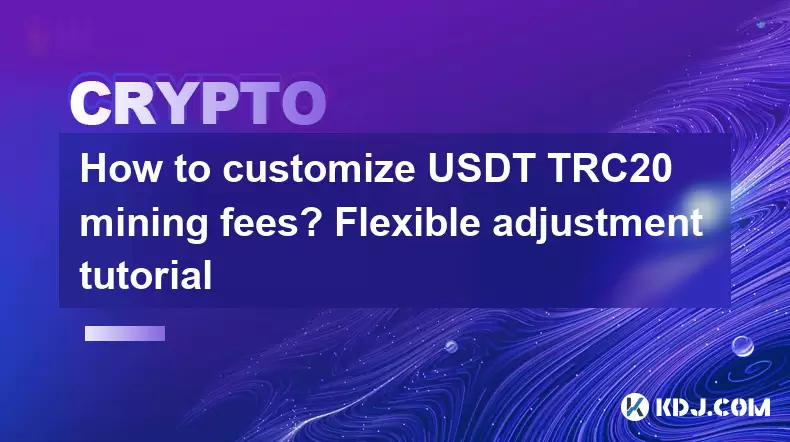
How to customize USDT TRC20 mining fees? Flexible adjustment tutorial
Jun 13,2025 at 01:42am
Understanding USDT TRC20 Mining FeesMining fees on the TRON (TRC20) network are essential for processing transactions. Unlike Bitcoin or Ethereum, where miners directly validate transactions, TRON uses a delegated proof-of-stake (DPoS) mechanism. However, users still need to pay bandwidth and energy fees, which are collectively referred to as 'mining fe...
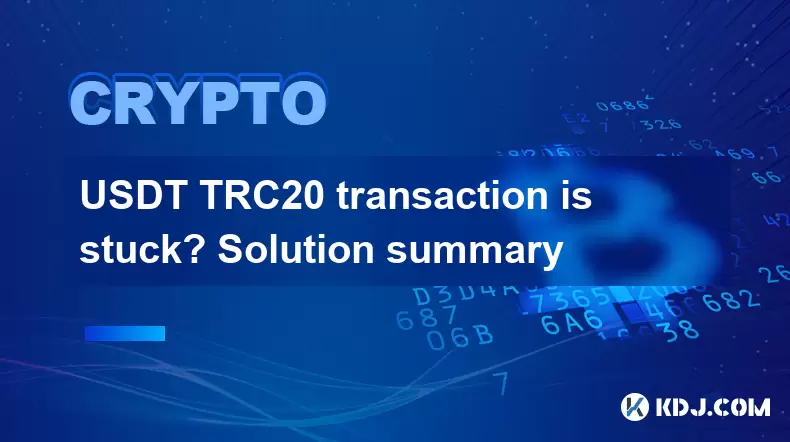
USDT TRC20 transaction is stuck? Solution summary
Jun 14,2025 at 11:15pm
Understanding USDT TRC20 TransactionsWhen users mention that a USDT TRC20 transaction is stuck, they typically refer to a situation where the transfer of Tether (USDT) on the TRON blockchain has not been confirmed for an extended period. This issue may arise due to various reasons such as network congestion, insufficient transaction fees, or wallet-rela...
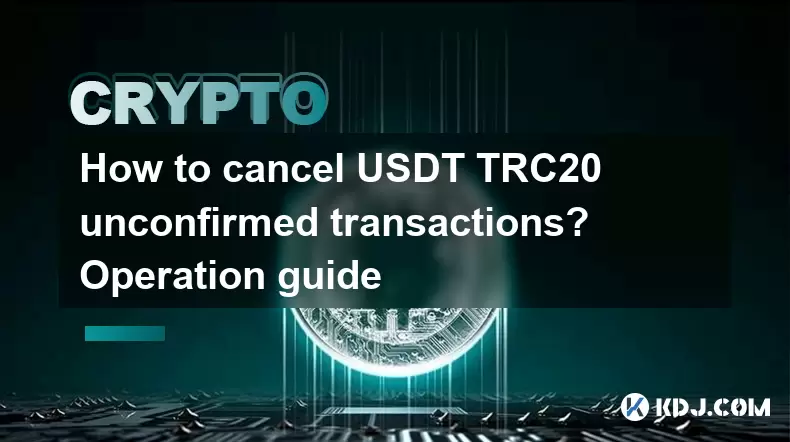
How to cancel USDT TRC20 unconfirmed transactions? Operation guide
Jun 13,2025 at 11:01pm
Understanding USDT TRC20 Unconfirmed TransactionsWhen dealing with USDT TRC20 transactions, it’s crucial to understand what an unconfirmed transaction means. An unconfirmed transaction is one that has been broadcasted to the blockchain network but hasn’t yet been included in a block. This typically occurs due to low transaction fees or network congestio...
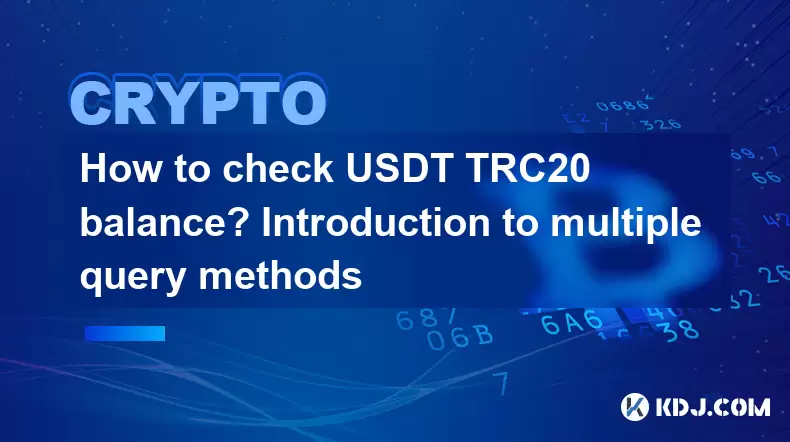
How to check USDT TRC20 balance? Introduction to multiple query methods
Jun 21,2025 at 02:42am
Understanding USDT TRC20 and Its ImportanceUSDT (Tether) is one of the most widely used stablecoins in the cryptocurrency market. It exists on multiple blockchain networks, including TRC20, which operates on the Tron (TRX) network. Checking your USDT TRC20 balance accurately is crucial for users who hold or transact with this asset. Whether you're sendi...
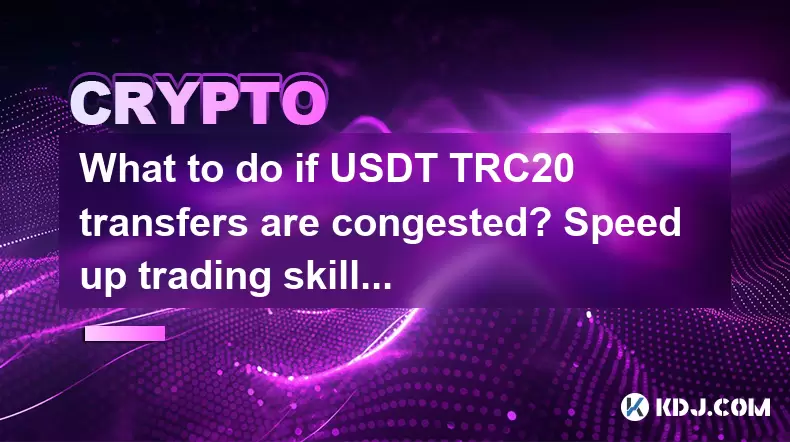
What to do if USDT TRC20 transfers are congested? Speed up trading skills
Jun 13,2025 at 09:56am
Understanding USDT TRC20 Transfer CongestionWhen transferring USDT TRC20, users may occasionally experience delays or congestion. This typically occurs due to network overload on the TRON blockchain, which hosts the TRC20 version of Tether. Unlike the ERC20 variant (which runs on Ethereum), TRC20 transactions are generally faster and cheaper, but during...
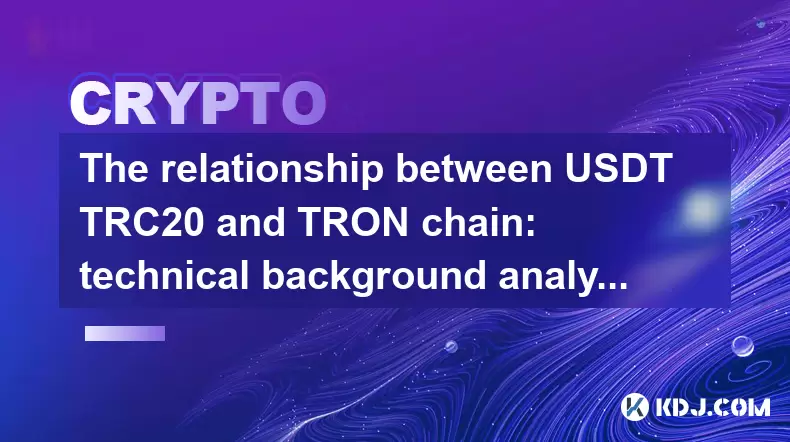
The relationship between USDT TRC20 and TRON chain: technical background analysis
Jun 12,2025 at 01:28pm
What is USDT TRC20?USDT TRC20 refers to the Tether (USDT) token issued on the TRON blockchain using the TRC-20 standard. Unlike the more commonly known ERC-20 version of USDT (which runs on Ethereum), the TRC-20 variant leverages the TRON network's infrastructure for faster and cheaper transactions. The emergence of this version came as part of Tether’s...

How to customize USDT TRC20 mining fees? Flexible adjustment tutorial
Jun 13,2025 at 01:42am
Understanding USDT TRC20 Mining FeesMining fees on the TRON (TRC20) network are essential for processing transactions. Unlike Bitcoin or Ethereum, where miners directly validate transactions, TRON uses a delegated proof-of-stake (DPoS) mechanism. However, users still need to pay bandwidth and energy fees, which are collectively referred to as 'mining fe...

USDT TRC20 transaction is stuck? Solution summary
Jun 14,2025 at 11:15pm
Understanding USDT TRC20 TransactionsWhen users mention that a USDT TRC20 transaction is stuck, they typically refer to a situation where the transfer of Tether (USDT) on the TRON blockchain has not been confirmed for an extended period. This issue may arise due to various reasons such as network congestion, insufficient transaction fees, or wallet-rela...

How to cancel USDT TRC20 unconfirmed transactions? Operation guide
Jun 13,2025 at 11:01pm
Understanding USDT TRC20 Unconfirmed TransactionsWhen dealing with USDT TRC20 transactions, it’s crucial to understand what an unconfirmed transaction means. An unconfirmed transaction is one that has been broadcasted to the blockchain network but hasn’t yet been included in a block. This typically occurs due to low transaction fees or network congestio...

How to check USDT TRC20 balance? Introduction to multiple query methods
Jun 21,2025 at 02:42am
Understanding USDT TRC20 and Its ImportanceUSDT (Tether) is one of the most widely used stablecoins in the cryptocurrency market. It exists on multiple blockchain networks, including TRC20, which operates on the Tron (TRX) network. Checking your USDT TRC20 balance accurately is crucial for users who hold or transact with this asset. Whether you're sendi...

What to do if USDT TRC20 transfers are congested? Speed up trading skills
Jun 13,2025 at 09:56am
Understanding USDT TRC20 Transfer CongestionWhen transferring USDT TRC20, users may occasionally experience delays or congestion. This typically occurs due to network overload on the TRON blockchain, which hosts the TRC20 version of Tether. Unlike the ERC20 variant (which runs on Ethereum), TRC20 transactions are generally faster and cheaper, but during...

The relationship between USDT TRC20 and TRON chain: technical background analysis
Jun 12,2025 at 01:28pm
What is USDT TRC20?USDT TRC20 refers to the Tether (USDT) token issued on the TRON blockchain using the TRC-20 standard. Unlike the more commonly known ERC-20 version of USDT (which runs on Ethereum), the TRC-20 variant leverages the TRON network's infrastructure for faster and cheaper transactions. The emergence of this version came as part of Tether’s...
See all articles

























































































